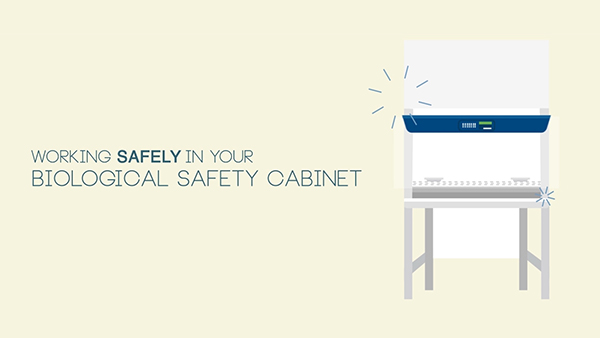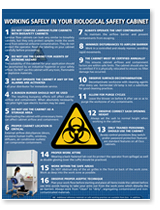Working safely in your biological safety cabinet

Biological Safety Cabinets provide the proper protection that you need when handled properly. But the protection provided by these cabinets is only as effective as the operator's proper usage and technique. Proper handling and maintenance are crucial factors in working effectively in a biological safety cabinet.
Here are some tips and reminders on working safely in your Biological safety cabinet.
- Do not confuse Laminar Flow Cabinets with Biological Safety Cabinets. Laminar Flow Cabinets do not provide user protection. Make sure to use a Biological Safety Cabinet when dealing with biohazards.
- If handling small amounts of chemicals, use ducted biosafety cabinets.
- Do not operate the cabinet if any of the alarms are activated.
- A Bunsen burner should not be used. The resulting buoyancy effect will affect cabinet air flow and containment.
- Do not use the cabinet as a storage area. Overloading the cabinet with unnecessary items can affect cabinet airflow and containment.
- Proper cabinet location is critical. External airflow disturbances (Doors, Excessive Human Traffic, Windows, Diffusers, Air Conditioner Outlets) can compromise containment.
- Always operate the unit continuously. To maintain the airflow barrier and prevent contaminants from escaping.
- Minimize disturbances to airflow barrier. Work in a controlled and steady manner, avoiding rapid movements.
- Make sure to have your cabinet recertified once a year to ensure efficiency and safety.
- Observe surface decontamination. Decontaminate work zone with cleaning agents before and after use.
- Allow for purge cycles. Leave the blower on before and after use so as to purge the work zone of any contaminants.
- Observe correct sash opening height. Always set the sash to the work height when working in the cabinet.
- Only trained personnel should use the cabinet. Access control provisions (key switch and/or password protection) are standard features on most Esco cabinets.
- Proper work attire. Wearing a back-fastened lab coat (to protect the operator from splashes) as well as double gloving (over the cuffs) should be practiced.
- Work within the safe areas. Do not obstruct any of the air grilles in the front or back of the work zone.
- Observe proper aseptic technique. Work from clean to dirty. Segregate contaminated from sterile materials.
Download printable "Working Safety in your Biological Safety Cabinet" Poster
For an easier and a more enjoyable way to learn how to work safely in your biological safety cabinet, watch and share our video below

